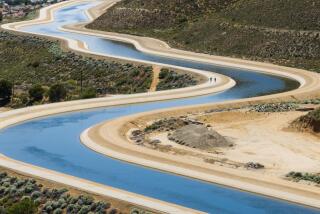State May Deliver Just 10% of Water Ordered : Drought: MWD expects blow to be softened by full allotment from Colorado Aqueduct. But Kern County farmers may face hardships.
- Share via
SACRAMENTO — With rainfall already below average and reservoirs at the lowest levels since the historic drought of 1977, officials have quietly advised the Metropolitan Water District of Southern California and other agencies to expect no more than 10% of requested deliveries from the State Water Project next year.
“What we’re projecting now is based on what we know we have. In other words, we are not extending our bank account,” said John Silveira, deputy director of the state Water Resources Department.
He said the state will announce the projections officially as required on Dec. 1, but because the announcement is expected to be unusually grim this year, water users have been given an informal assessment of water supply conditions in advance.
The federal Central Valley Project meanwhile, will not make an official projection until Feb. 15, although it too has advised its contractors to be prepared for reduced deliveries. “We said they can expect no more than they got last year,” said Central Valley Project spokesman Jeff McCracken.
Depending on the type of contracts they held, federal water customers were cut either 25% or 75% last year. The federal project primarily serves farmers in the Central Valley while the state project supplies a mostly urban population of 20 million in Central and Southern California and parts of the San Francisco Bay Area.
Silveira said the initial state projections, which will be updated throughout the winter rainy season, show the extent to which the water system has become “stressed” after six years of drought. While December water supply forecasts are typically more pessimistic than those that are given after the heavy winter rainfall months, rarely does the department project deliveries as low as 10%.
Silveira acknowledged that state officials are being more conservative than normal because reserves have reached near-record low levels at a time when demands are increasing for water for the environment. Water officials said rainfall in key watersheds in Northern California has been 72% of normal for this time of year.
The latest water rationing is expected to hit farmers the hardest, especially those on the west side of Kern County who depend almost exclusively on the State Water Project for their supplies. Farmers who have access to ground water and urban areas with other sources of water--such as areas of Southern California served by the MWD--will not be affected as heavily.
“It doesn’t do anything to us immediately. We have assumed all along that the initial allocation was going to be 10% of our order,” said Jay Malinowski, MWD’s assistant chief of operations.
At that percentage, Malinowski said the district would only receive 207,000 acre-feet instead of the 2.1 million acre-feet it requested. An acre-foot of water is roughly 326,000 gallons and supplies about three families for a year.
With full deliveries expected from the Colorado Aqueduct, the district’s other major source of water, Malinowski said MWD is assured of about 1.6 million acre-feet for next year. While that is 300,000 acre-feet short of meeting demands, he said the district expects to make up the remainder by purchasing water from other sources.
He said the district “is not anticipating mandatory rationing” next year, in part because customers have continued to conserve water.
Even if the state ultimately increases its water allocations, it may be too late for some farmers who use the Dec. 1 announcement to plan their crops and obtain financing.
“It’s an extremely tough situation for them,” said Silveira.
George Baumli, general manager of the State Water Contractors association, said water officials can only guess what the weather picture for the coming year will be, but they do know “we will have to have heavy and continuous storms” before deliveries can reach anything approaching normal.
A looming problem for water officials, he said, is potential environmental constraints that could force the project to provide additional water to the environment.
“There is simply not enough water to go around,” Baumli said. “The California water infrastructure is over-stressed and when you superimpose the problems of drought, endangered species and possible new water quality standards, it becomes overwhelming.”
The State Water Resources Control Board is expected this year to announce new interim water quality standards for the Sacramento-San Joaquin River Delta that would further reduce water exports. In January, the National Marine Fisheries Services is expected to demand that additional constraints be placed on the water projects to protect the endangered winter-run Chinook salmon on the Sacramento River.
More to Read
Sign up for Essential California
The most important California stories and recommendations in your inbox every morning.
You may occasionally receive promotional content from the Los Angeles Times.










